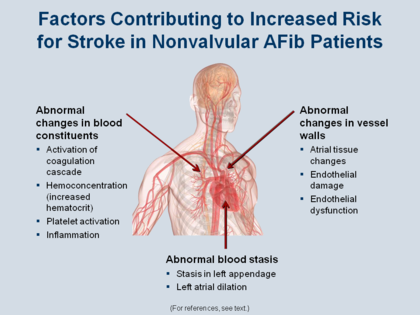Reiffel - Atrial Fibrillation and Stroke: Epidemiology - Figure 11
Factors contributing to increased stroke risk
There are 3 principal factors that contribute to the increased risk for stroke in patients with nonvalvular AFib:
- Abnormal changes in the atrial wall
- Abnormal blood stasis
- Abnormal changes in the blood constituents
What is it about each of these factors that contributes to increased risk for stroke and non-valvular AFib, and what is it about AFib that adds to this risk?
In AFib, particularly in the setting of structural disorders, there are abnormal changes in the atrial wall – atrial tissue changes, endothelial damage, and endothelial dysfunction, (which we will come back in a moment).[20] This is an important and often overlooked component of this problem.
Also in AFib, when the atrial wall fibrillates it leads to abnormal stasis in the blood flow, and this hemodynamic change may add to the risk imposed by the disorders that affect the atrial wall and endothelium.
Finally, there may be abnormal changes in the blood constituents – the activation and coagulation cascade components – in the fibrillating atrium, and these will be discussed as well.

